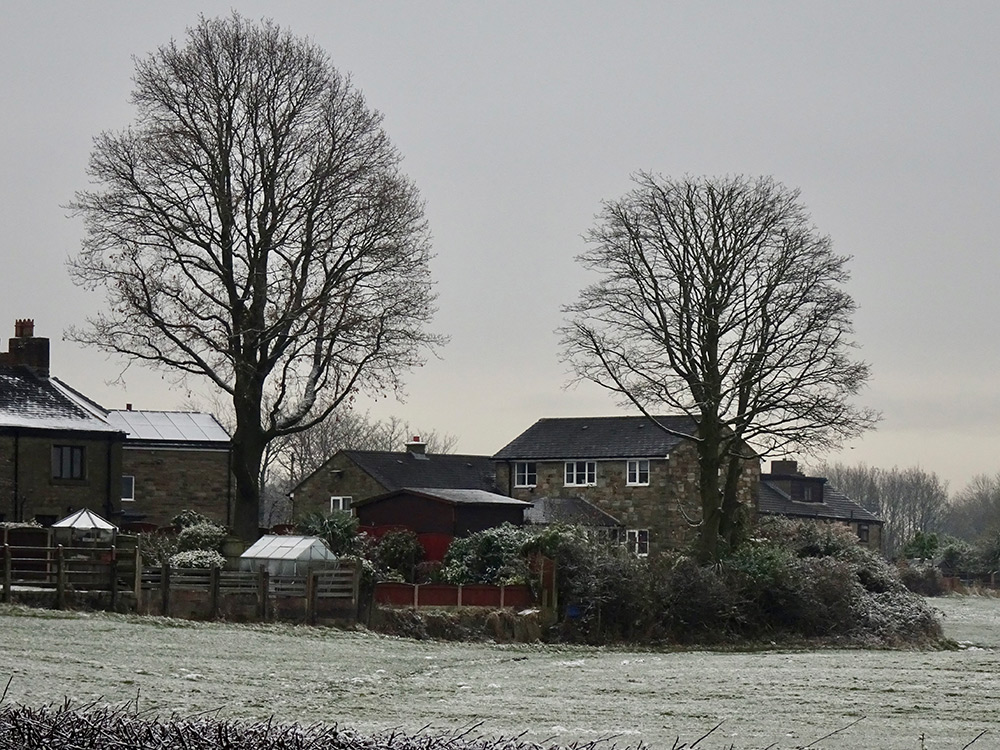Photo-a-Day (Friday, 17th December, 2021)
The End Of Duke’s Row, Aspull

Photo: Dennis Seddon (Sony DSC-WX500)
Grand photo is that Dennis, the starting point of so many stories. One of the taller buildings was once the Winding House for the mine shaft. I remember being a young boy of about five years old, 70 years ago now, mi mam sent me to see Mrs Collier who lived in that old house, she was brilliant with needle and thread, repairing worn out and damaged clothes, I had torn the britches a*r*e out of my short trousers. From the upstairs window you could look down the mine shaft. Sometime in the late 1970s I recall the mine shaft being the site of lots of activity when it collapsed needing tons upon tons of concrete pumped down to make safe. To the left is Dukes Row once known as Fothershaw Row. To the right Moss Pit Row ! where was Moss Pit ? (anyone know). You mentioned Gullet Pit, Bolton Road was once known as Upper Gullet and further down Lower Gullet. There were so many mines in Aspull no wonder Lord Crawford was a rich man, owning all of them I think.
Why wasn’t it called the great Aspull sough then?
The original stretch of the Sough was constructed by the Bradshaigh Family from 1653 to1670. It ran from the outlet at the Yellow Brook in Bottling Wood to the Park Pit, on the right just after the main drive bridge over the canal.
In 1853 the Sough was extended to Fothershaw Pit and extended again after 1866 to Aspull Pumping Pit. At this Pit the water was pumped up to the level of the Sough and from there it ran, by gravity, all the way down to the outlet in Bottling Wood and via the Yellow Brook to the River Douglas.
By agreement the Pumping Pit carried on pumping water until 1932 so that mines in Blackrod could carry on working. When pumping ceased it meant that the water level rose and Pits in the area could not carry on.
There was another Sough in the area, Gerrard’s Sough, that emptied into Clarington Brook, but it was not as long as Haigh Sough and not as well known.
It doesn’t seem to make a lot of sense, pumping water from underneath Blackrod, uphill to Aspull, only to let it run back down again at the other side of the high ground in a different drainage area, when it could easily have been let into it’s own drainage area?
George, the Pits in Blackrod and Westhoughton did not belong to Wigan Coal and Iron but, because they had workings below the level of the Sough they needed Aspull Pumping Pit to keep going to prevent their workings being flooded.
After the closure of Top Place at Kirkless in the 1920s most of the mines in Aspull and Haigh that supplied Top Place ceased production and Wigan Coal and Iron had no reason to keep the Pumping Pit working.
After lengthy legal proceedings the Pumping Pit ceased pumping in 1932, and that meant that the underground water level naturally rose to the level of the Sough thereby flooding and making unviable the Blackrod Pits.
When the Pumping Pit was working, water from the pumps wasn’t pumped to the surface, it was only pumped to the level of the Sough. From there it ran down the Sough by gravity into the valley of the River Douglas.